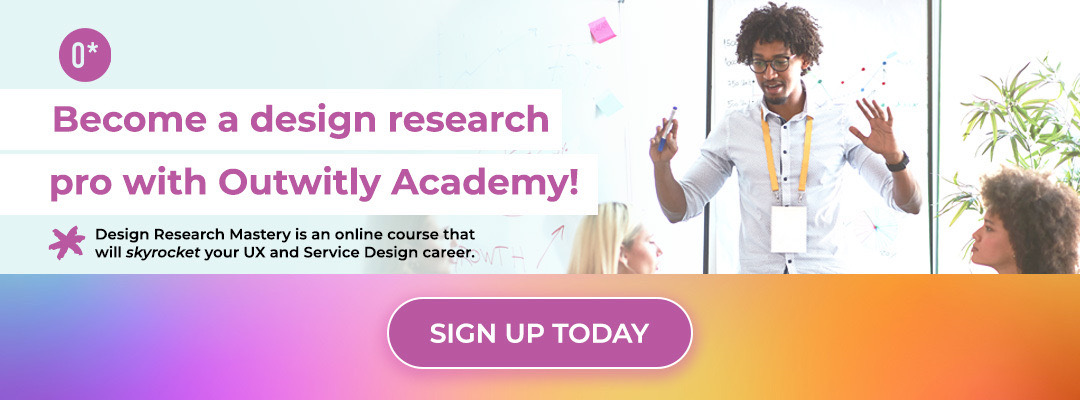
Here at Outwitly, UX and design research is our passion, and what we do best — so much so that we created an entire course about it! We do research to…
-
- Explore — uncover pain points, frustrations, and challenges; understand user motivations, goals, and unspoken needs; and understand user behaviours, tasks and actions.
- Empathize — to get to know our users (or stakeholders!) in a more meaningful way, and to understand who they are as humans.
- Innovate — to provide inspiration and guidance in developing new and novel ideas for design.
- Improve and Enhance — to provide information that will help designers to improve user and customer experience. How can we find areas for improvement within existing products and services?
Today’s post is going to introduce our favourite qualitative research methods (in-depth interviews, observations and diary studies) that you can start applying to your UX and design research projects immediately! All of these methods fall under human-centered design methodology, and involve uncovering insights that will lead to innovation.
Let’s get started.
Design Research Method #1 — In-Depth Interviews
Research Purpose: In-depth interviews are meant for understanding perceptions, expectations, overall satisfaction, challenges, needs, desires and motivations. They’re also helpful for developing a set of user personas.
What type of research do in-depth interviews fall under? In-depth interviews are a primary, qualitative research method, used for exploratory research. They’re considered a self-reporting activity.
What are in-depth interviews? The in-depth interview is a key ethnographic research method, used in almost every research project! To be considered “in-depth,” interviews should be conducted one-on-one for a minimum of 30 minutes, or ideally, 60 minutes. This allows us to profoundly understand an individual’s thoughts and experiences. Keeping the interviews one-on-one helps prevent the influence of another person’s opinion.
They should also be semi-structured, meaning you use an interview guide with preset questions, while leaving room for the interviewee to bring up ideas you may not have thought to ask about. Interviewing is truly an art form! You need to be in tune with how comfortable your interviewee/research participant feels, and enable them to open up to you — a complete stranger — about their challenges.
Why is an in-depth interview such a great research method?
- It allows researchers to gather a lot of information at once with relative logistical ease.
- It can be conducted either in-person or remotely.
- It’s easy to document the interview data, analyze the data, and find patterns in it.
- It’s also easy to refer back to the data and see where insights were drawn from. In other words, there’s less room for subjective interpretation.
- It can help you understand the interviewee’s needs, goals, pain points and motivations.
For more information on in-depth interviews, including interview logistics and best practices, click here.
Design Research Method #2 — Observations
Research Purpose: Observations help researchers understand people’s behaviours, how they go about tasks or interact with products or services, and their current-state journeys or processes. This all comes in handy when it’s time to develop a set of user personas.
What type of research do observations fall under? The use of observations is categorized as a primary, qualitative research method, great for exploratory research. Observations also considered to be field research, unlike interviews and diary studies.
What are observations? Observations, also known as “design ethnography,” are focused on understanding user behaviours, unspoken needs, and challenges, in-person and in real time. To conduct observations, the researcher will silently observe how a user goes about their day, how they might interact with a product or service, or how they might use the application in real life!
In general, people aren’t very good at remembering all of the tasks and actions they take to try to accomplish something, or at articulating their own behaviours during user interviews. They may falsely remember, exaggerate, or underrepresent certain challenges. By observing them as they use a product or service, you’re able to pick up on issues they might not tell you about. For this reason, data triangulation is critical (keep scrolling down for more on that topic!).
Why are observations a great research method?
- They allow you to immerse yourself into people’s day-to-day lives, so you can build more empathy for them.
- They provide context to help you see where the user is, what their environment looks like, and other factors that might affect their behaviours!
- They help you understand behaviours, tasks, processes and pain points.
- They reveal unspoken needs and processes that wouldn’t otherwise be uncovered through self-reporting methods like interviews.
For more information on observations, including how to build an observation field kit, a “what-to-bring” checklist, and tips for a successful observation day, click here.
Design Research Method #3 — Diary Studies
Research Purpose: Diary studies are meant for understanding behaviours and the current-state journey or process.
What type of research do diary studies fall under? A diary study is a form of primary and qualitative research, used for exploratory research. Like interviews, they are self-reporting!
What are diary studies? In a diary study, participants are asked to report on their experience in a journal format over a period of time (e.g. two weeks.) They’re asked create a log of their day-to-day interactions with a product, service, or organization, their thoughts and feelings, and even take pictures or videos. The participants are in charge of what they log, but this mode of research gives them many opportunities during the set time period to add and jot down details they may not remember during an in-person interview or observation session!
While diary studies are sometimes analogue exercises (think old school, with a physical journal and a pen), they can also be digital, where participants take pictures and videos along the way to help further communicate their experience. Try our favourite digital diary study tool, dscout.
Why are diary studies a great research method? They help researchers to…
- Understand habits and behaviours that reoccur every day.
- Understand how interactions, perceptions, and behaviours change over time.
- Build journey maps with an understanding of how participants interact with a product or service over time, as well as the various touch points they encounter.
- Understand the real-life experiences of their participants in context.
For more information on setting up a diary study and analyzing uncovered data, click here.
Gathering Robust Insights with Data Triangulation
To ensure the data you collect is accurate and useful, it’s important to employ “data triangulation!” This is the method of gathering, collecting and validating research findings using multiple sources and research methods. What you see and hear across the various research methods and settings should line up, and help you gather more robust insights. These insights enable researchers to better understand user behaviours, motivations and pain points with relation to a current service or product.
At Outwitly, we believe that mixed research methods and data triangulation are a must for any research project. We typically use three or more different methods for any given initiative, using a combination of in-depth interviews, observations, diary studies, workshops and surveys to reveal users’ articulated and unarticulated needs. You may also want to do some secondary research to see what has already been done in the space! Take a look at the diagram below for a visual representation of data triangulation.
View this post on Instagram
We hope throughout this blog post, you learned more about the importance and intention behind in-depth interviews, observations and diary studies! Remember, when conducting research, it’s uber-important to employ multiple methods across various settings to ensure your insights are robust.
As we mentioned, research is our jam. Stay in the know by following us on Instagram, Pinterest and Twitter, and signing up for our weekly newsletter.





